2006 Season in Review
November 6th, 2006
The 2006 season was my first coaching since 2002. After the 2002 season there were a few things we did that I liked and disliked. When it came to putting together a playbook for the 2006 campaign I incorporated a few new ideas. However even the best laid plans evolve and change. This season I made more adjustments with our offense than I had in my other two seasons combined. I felt it helped our team and the single wing is versatile enough that these changes were easily learned by our 8-10 year old players.
I came into this season with a single wing based on a streamlined, youth version of Dr. John Ward’s single wing which included an unbalanced line to the right, severe angle blocking with four points of attack. In 2002 I took a minimalist approach with only 6 plays. I wanted to expand on this a little but keep the number of plays under 10. What follows is an explanation of these plays with accompanying diagrams and sample video can be found here. Download the entire PDF here.
Tailback Off-Tackle
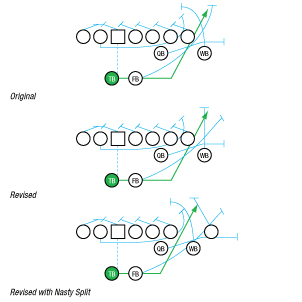
The primary play associated with the single wing is the off-tackle play and my playbook began here. We severely angle blocked the strong side of the formation with the quarterback kicking out the defensive end. The left guard pulled and led through through the hole along with the fullback. Originally I had the wingback automatically angle blocking regardless of the defensive alignment. As the season moved along we saw opponents a second time so we changed the responsibilities of the wingback. Since none of the defenses we faced lined up a defender over our right end which would’ve been the wingback’s responsibility, we had the wingback block the outside linebacker that was in the target area.
The strongest opponent we faced lined their defensive end up on the outside shoulder of our right end. So we added the nasty split to our plays for the last two games of the season. This enabled the off-tackle hole to widen and create more running room. Plus is allowed our pulling guard and tailback to hit the hole quicker. In our offense I would call the normal play and shout “nasty” if we wanted the right end to split a yard or so. We left the wingback in the slot created by the nasty split. Our rules were that the outside person, the right end in “nasty” or the wingback in normal tight formation, blocked the outside linebacker. We alternated our wingback and right end by quarter so when one was the right end the other was the wingback. If the defensive end didn’t move with our right end then the defensive was set up for a sweep.
Tailback Sweep
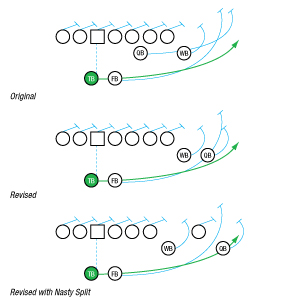
Our sweep was a powerful compliment to our off-tackle play early in the 2006 season. We had nice success with it but teams in the second half of the season began to load up to take away the sweep. After a few weeks of practice we found our quarterback was not getting outside quick enough to lead block the sweep so we decided to flank him outside the wingback for this play and the sweep pass. We found it helped our quarterbacks recognize their target block and allowed them to get into the pass pattern quicker.
Once we added the nasty split to our arsenal we could incorporate it for other plays and formations. When we split the right end for the sweep we kept the wingback in the slot and the quarterback on the outside of the right end. This created nice blocking angles on the defense.
Tailback Sweep Pass
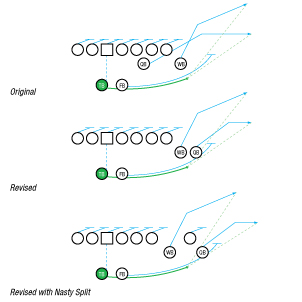
This play is our version of this single wing staple. We don’t pass often but we try to use it when the defense isn’t expecting it. Also it is handy when teams are stacked up defensively to stop our running plays. After we moved our quarterback to the flank along with the wingback for the sweep run we also did the same thing for the sweep pass. This way we weren’t tipping our hand and when we made a “nasty” call it gave us another blocker in front of our tailback.
Fullback Wedge
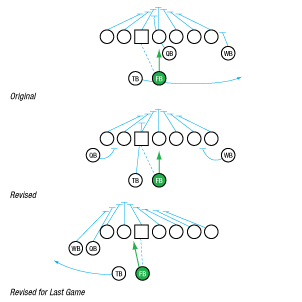
The original design of the fullback wedge used the right guard as the apex of the wedge and the tailback faking long side sweep. Early in the season this play wasn’t doing the job we had hoped so we made a few adjustments. To prevent defensive pursuit from behind, particularly our left side, we lined up our quarterback on the wing of our left end. This had immediate impact since our wedge wasn’t hitting quick enough we were able shore up the left side. We also found a seam formed on the left side of the wedge that usually ended up with a defender making the tackle. To fix this we sent our tailback ahead of the fullback and lead block. This helped to strengthen the play.
For our last game we decided to move the wedge apex to our left guard. He was our best lineman and gave us a new wrinkle for a tough opponent. Since the left side is our short side of our formation we flanked both the wingback and the quarterback so the formation resembled our wingback power formation. Now these two players were asked to become part of the wedge and we had our tailback fake to the short side hoping to freeze the weak side defense.
Wingback Counter
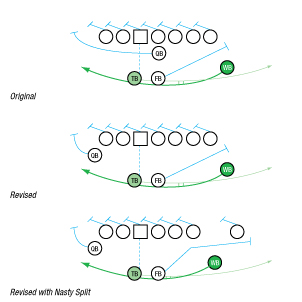
In the 2002 season I was not happy with the results of this play. The wingback took a very flat path to the point of attack and unfortunately the hole became clogged with blockers as well and the wingback was unable to maneuver upfield. I redesigned the play so the wingback’s path was a little deeper so he would be able to turn up into the hole more vertically. We accomplished that by lining him a little deeper into the backfield than normal and using an outside hand-off. To prevent a cluttered point of attack we switched the blocking scheme to an outside sweep scheme.
As the 2006 season progressed we started to use our quarterback on the left flank for the fullback wedge so it made sense to use the quarterback in this position for the wingback counter play as well. This allowed our quarterback to engage his block much sooner. We also added a nasty split for the right end on occasion to push out the defensive end and prevent him from chasing from behind. By having our wingback line up in the slot created by the nasty split it actually moved the wingback a bit closer to the tailback and allowed an even quicker hand-off.
Wingback Power
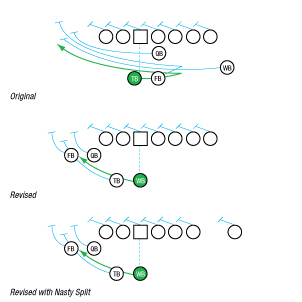
The original design of this play was a tailback counter play I picked up at the 2006 Single Wing Conclave. I wanted to have a power play to the weak side and seeing this play in action seemed to be the solution for that problem. Unfortunately we didn’t have a lot of success with it when we used in games. Our tailback was not selling the strong side run before cutting back to the weakside. The jab step action is intended to allow the fullback and wingback to get in front of the tailback.
In one specific game there was a very aggressive weak side defensive end and my coaching instincts were to attack that player instead of running away from him. The tailback counter play was supposed to be my answer and it didn’t produce. We left that game a little frustrated.
After that game I took a look at this play and made a few decisions. Our wingback was left-handed and a very strong runner, very much like a fullback. I decided that he should be running the ball more often. So we lined him up at the fullback position and put our fullback on the weak side flank along with the quarterback. Snap to the wing back and follow his blockers. The results were immediate. In one game our wingback had 75 yards and a touchdown primarily on this play alone. We were able to take advantage of a defense that placed their strongest players on our long side leaving inferior players on the weak side.
Quarterback Buck Lateral

This is a play I began using in 2002. It was a great method to get our quarterback an opportunity to carry the football. We ran a lot of fullback wedges and our opponents were very aware of this threat. So I took a little page out of the buck lateral series but used the wedge blocking scheme. I didn’t look at this play as part of the buck lateral series but as a compliment to the wedge play. That season I even pulled a tackle to lead this play along with the tailback and wingback. This play gave a few big third down conversions that season.
In 2006 we used a slightly simplified version. I kept the tackle in as part of the wedge blocking. The wingback’s job is to seal the defensive end. We don’t run this play very often but we did score once in six games.
Quarterback Wedge

Originally my 2006 playbook included two fullback spin plays — fullback keeper to the off-tackle hole and the snap to the quarterback with full spin deception by the fullback, tailback and wingback behind. I scrapped the spin plays because we were still perfecting our other plays and we couldn’t afford the time it would take to practice the techniques.
I still wanted the short, soft snap to the quarterback position with the wedge blocking. We simply used the same formation as the wingback power play, cheated the quarterback in toward our snapper, snapped to him, wedged and had the tailback and wingback run and fake in opposite directions. We also experimented with the path the quarterback takes once he has the ball. We tried having him run along the back of the wedge to the ride side as well straight up into the wedge. We some success with both methods.
Conclusion
The 2006 football season provided me the opportunity to treat the single wing as my personal laboratory. With a seventeen player squad with fourteen first-time players it was my job as their coach to put them in position to succeed. In this case we modified and tweaked plays I originally had drawn in order for our young players to succeed on the football field. Much of my thinking in terms of variations came from Dr. Ken Keuffel’s books and e-mail conversations I had with him before his passing. The single wing is a wonderful offense that is versatile, flexible and time-tested where coaches will be able to troubleshoot and find the necessary adjustments to solve their offense’s challenges.
Snap & Go!
Adam
adam_wesoloski at yahoo.com